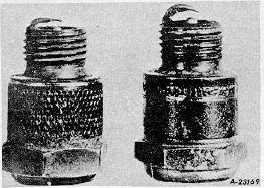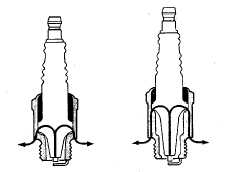|
| |
TRUCK SERVICE MANUAL
TM 5-4210-230-14&P-1
ELECTRICAL
has become worn away or the ground electrode has become
so badly eroded at the sparking area that resetting of the gap
is either difficult or impossible, the spark plug is not fit for
further efficient engine service--even if cleaned.
Fig. 17 Condition of Electrodes
CLEANING AND SETTING
Remove spark plug gaskets if plugs are to be cleaned.
Remove oily deposits from both firing end and outside
surface of plug using a commercial cleaning solvent which
dries quickly. Failure to remove oil from spark plugs will
result in cleaner abrasive packing inside the firing end of
spark plug if an abrasive type cleaner is used.
Use the instructions provided with the liquid spark plug
cleaner and tester (SE-2190) and be sure the plugs are
thoroughly dry before testing.
If an abrasive type plug cleaner is used, be sure the
spark plugs are free of abrasive material before testing.
Pass a thin point file between center and ground
electrodes to smooth up both surfaces.
Reset gap by moving ground side electrode only. Do
not touch center electrode, as insulator tip fracture may result.
Bend ground electrode toward center electrode.
Using a wire feeler gauge, gap plugs to specifications.
A very slight drag should be felt when feeler gauge passes
between electrodes.
Use the instructions provided with the tester to check
spark plugs.
NOTE:
Never assume you are simulating cranking
compression when using the tester. Air
pressure in a bench tester has no direct
relation to engine compression for the
following reasons:
1.
There are no temperature effects in the bench
test. Heated electrodes within warm cylinders in an
engine require less voltage than under a cold bench
test.
2.
There is no fuel/air charge in the bench tester.
3.
Since spark plug firing is dependent on engine timing,
firing of the spark plugs is not always at the point of
maximum compress ion.
4.
There is no cylinder turbulence in the tester pressure
chamber.
Because of these variables, the bench test, while
useful, cannot be measured by any specific psi readings.
HEAT RANGE
Spark plug heat range is the primary factor governing
spark plug performance under various service conditions.
The term "heat range simply refers to the classification of
spark plugs according to their ability to transfer heat from the
firing end of the plug to the cooling system of the engine.
The rate of heat transfer, or heat range, is controlled
basically by the distance between the inside gasket seat and
the insulator tip.
A "cold" type plug, Fig. 18, has a relatively short
insulator nose and transfers heat very rapidly into the engine's
cooling system. Such a plug is used in heavy-duty or
continuous high speed operation to avoid overheating.
MT-3754
Fig. 18 Construction and Heat Flow of "Hot” and "Cold"
Plugs
The "hot" type plug, Fig. 18, has a much longer
insulator nose and transfers heat more slowly away from its
firing end. Thus, it runs hotter and burns off combustion
deposits which tend to foul the plug during prolonged idle or
low-speed operation.
CTS-2016-J Page 7
PRINTED IN UNITED STATES OF AMERICA
|


